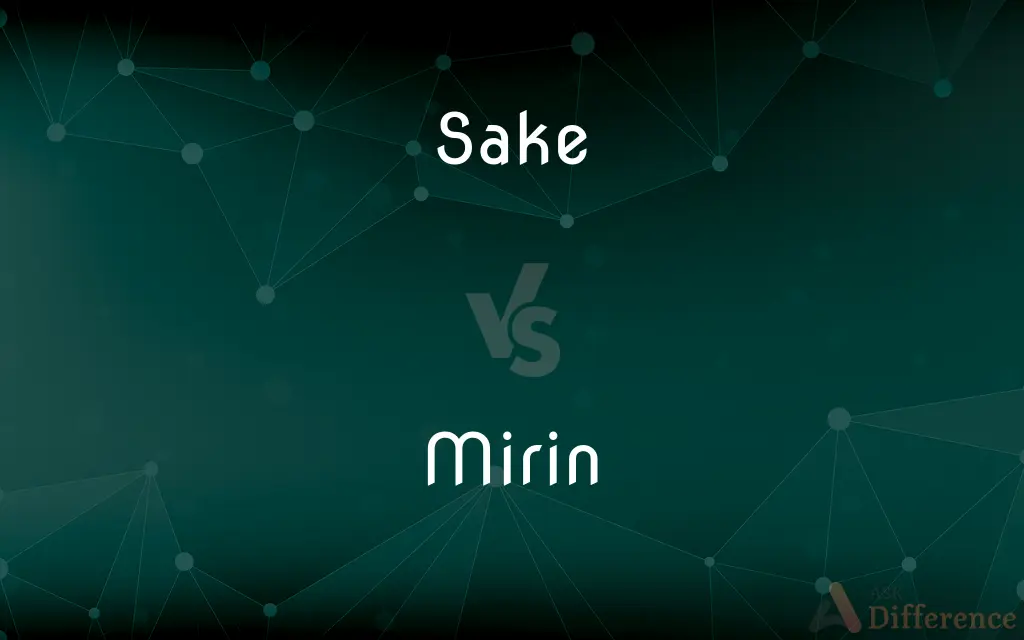Sake vs. Mirin — What's the Difference?
Edited by Tayyaba Rehman — By Urooj Arif — Updated on March 25, 2024
Sake is a Japanese rice wine for drinking, while mirin is a sweeter cooking wine.

Difference Between Sake and Mirin
Table of Contents
ADVERTISEMENT
Key Differences
Sake, often referred to as Japanese rice wine, is made from fermented rice and is a popular alcoholic beverage both in Japan and internationally. It has a wide range of flavors, from sweet to dry, and is served both warm and cold. On the other hand, mirin is a type of rice wine used primarily in cooking. It has a higher sugar content and a lower alcohol content compared to sake, lending a mild sweetness to dishes.
Sake is produced through a brewing process that is more akin to beer production, where the starches are first converted into sugars before being fermented into alcohol. Mirin, while also derived from fermented rice, includes added sugar or syrup, contributing to its sweetness. This sweet profile makes mirin an essential ingredient in many Japanese sauces and dishes, providing a balance of sweetness and umami.
While sake can be enjoyed as a beverage, mirin is rarely, if ever, consumed on its own due to its sweet profile and culinary purpose. Sake's role extends beyond being just a drink; it is also used in cooking, albeit less frequently than mirin. When used in cooking, sake can impart a rich umami flavor and help mask fishy odors, but it does not contribute the same level of sweetness as mirin.
Mirin's lower alcohol content (usually around 1% to 14%, depending on whether it's true mirin or a mirin-fu or mirin-like condiment) compared to sake (which typically ranges from 15% to 20% alcohol by volume) makes it less potent and more suitable as a cooking ingredient. The alcohol content in mirin helps to tenderize ingredients and enhance flavor absorption without overwhelming the dish.
Both sake and mirin hold cultural significance in Japan, reflecting the country's culinary traditions and history. Sake plays a central role in various Japanese ceremonies and festivals, symbolizing purification and unity. Mirin, while less ceremonial, is indispensable in the Japanese kitchen, contributing to the distinctive flavors of Japanese cuisine.
ADVERTISEMENT
Comparison Chart
Type
Alcoholic beverage
Cooking wine
Flavor
Ranges from sweet to dry
Sweet
Alcohol Content
15% to 20%
1% to 14%
Primary Use
Drinking, occasionally cooking
Cooking
Production
Fermented rice, similar to beer production
Fermented rice with added sugar or syrup
Culinary Role
Adds umami, masks odors
Adds sweetness, enhances flavor, tenderizes
Consumption
Served as a beverage, warm or cold
Used in cooking, not typically consumed alone
Compare with Definitions
Sake
Enjoyed in various temperatures.
Hot sake is popular in winter for its warming effect.
Mirin
A sweet Japanese cooking wine.
Mirin was used to sweeten the teriyaki sauce.
Sake
A traditional Japanese rice wine.
We toasted with a glass of sake at the dinner.
Mirin
Lower in alcohol than sake.
This brand of mirin has about 10% alcohol content.
Sake
Made by fermenting polished rice.
The sake brewery uses a special rice polished to 50%.
Mirin
Not for direct consumption.
Unlike sake, mirin is not typically drunk on its own.
Sake
Served at ceremonies.
Sake is often part of Shinto wedding ceremonies.
Mirin
Essential for Japanese cuisine.
Mirin is a key ingredient in miso glaze.
Sake
Used in cooking to add depth.
Sake was added to the marinade for its umami flavor.
Mirin
Adds a glossy finish to dishes.
The addition of mirin gave the dish a beautiful sheen.
Sake
Sake, also spelled saké ( SAH-kee, SAK-ay, also referred to as Japanese rice wine), is an alcoholic beverage made by fermenting rice that has been polished to remove the bran. Despite the name Japanese rice wine, sake, and indeed any East Asian rice wine (such as huangjiu and cheongju), is produced by a brewing process more akin to that of beer, where starch is converted into sugars which ferment into alcohol, whereas in wine, alcohol is produced by fermenting sugar that is naturally present in fruit, typically grapes.
Mirin
Mirin (味醂 or みりん, Japanese: [miɾiɴ]) is a type of rice wine and a common ingredient in Japanese cooking. It is similar to sake, but with a lower alcohol content and higher sugar content.
Sake
Purpose; motive
A quarrel only for the sake of argument.
Mirin
A sweet Japanese rice wine used especially in cooking.
Sake
Advantage; good
For the sake of his health.
Mirin
A form of Japanese rice wine, less alcoholic than sake and used in cooking.
Sake
Personal benefit or interest; welfare
For her own sake.
Sake
A Japanese alcoholic beverage made from fermented rice.
Sake
Cause, interest or account
For the sake of argument
Sake
Purpose or end; reason
For old times' sake
Sake
The benefit or regard of someone or something
Sake
Contention, strife; guilt, sin, accusation or charge
Sake
Final cause; end; purpose of obtaining; cause; motive; reason; interest; concern; account; regard or respect; - used chiefly in such phrases as, for the sake of, for his sake, for man's sake, for mercy's sake, and the like; as, to commit crime for the sake of gain; to go abroad for the sake of one's health.
Moved with wrath and shame and ladies' sake.
I will not again curse the ground any more for man's sake.
Will he draw out,For anger's sake, finite to infinite?
Knowledge is for the sake of man, and not man for the sake of knowledge.
Sake
A traditional alcoholic drink of Japan. It is made from rice.
Sake
A reason for wanting something done;
For your sake
Died for the sake of his country
In the interest of safety
In the common interest
Sake
Japanese alcoholic beverage made from fermented rice; usually served hot
Sake
The purpose of achieving or obtaining;
For the sake of argument
Common Curiosities
What is sake used for?
Sake is primarily a beverage enjoyed for its wide range of flavors, but it is also used in cooking to add depth and umami.
How does sake compare to wine?
Sake is similar to wine in that it is an alcoholic beverage made through fermentation, but it is made from rice instead of grapes and has a unique flavor profile.
Can non-alcoholic mirin be used?
Non-alcoholic versions of mirin, known as mirin-fu chomiryo, are available for those avoiding alcohol but still want the sweetness and flavor mirin provides.
Is there a ceremonial use for mirin?
Unlike sake, which has significant ceremonial use, mirin is primarily a culinary ingredient with no major ceremonial role.
Can you drink mirin?
While technically edible, mirin is not intended for drinking due to its sweet profile and is used almost exclusively for cooking.
Is mirin alcoholic?
Yes, mirin contains alcohol, but at a lower concentration than sake, making it less potent and more suited as a cooking ingredient.
Can mirin replace sake in cooking?
Mirin can sometimes replace sake, especially in recipes requiring sweetness, but it cannot fully replicate sake's flavor and alcohol content.
Why is mirin important in Japanese cooking?
Mirin adds sweetness, depth, and a glossy finish to dishes, balancing other flavors like soy sauce and contributing to the overall umami experience of Japanese cuisine.
Can I use sake instead of mirin?
Sake can be used with added sugar to mimic mirin's sweetness, but the result may not be identical due to differences in flavor and alcohol content.
How do you store sake and mirin?
Sake should be stored in a cool, dark place and consumed relatively soon after opening. Mirin, due to its higher sugar content, has a longer shelf life and can be stored similarly.
Can sake and mirin be mixed in cooking?
Yes, combining sake and mirin in cooking can add complex flavors, combining the umami and masking abilities of sake with the sweetness of mirin.
What dishes use mirin?
Mirin is used in a variety of Japanese dishes, from teriyaki sauce to miso glaze and sushi rice seasoning.
What makes sake different from other spirits?
Sake's unique production process and ingredients (fermented rice) set it apart from other spirits, which are usually distilled and made from different base materials.
Are there any health benefits to consuming sake or mirin?
In moderation, sake can offer health benefits similar to other alcoholic beverages, such as heart health. Mirin, used sparingly in cooking, contributes minimal health benefits due to its sugar content.
How does the alcohol content affect sake and mirin's uses?
The higher alcohol content in sake makes it suitable as a beverage, while mirin's lower alcohol and higher sugar content make it ideal for cooking.
Share Your Discovery

Previous Comparison
Same vs. Different
Next Comparison
Doctor vs. PhysicianAuthor Spotlight
Written by
Urooj ArifUrooj is a skilled content writer at Ask Difference, known for her exceptional ability to simplify complex topics into engaging and informative content. With a passion for research and a flair for clear, concise writing, she consistently delivers articles that resonate with our diverse audience.
Edited by
Tayyaba RehmanTayyaba Rehman is a distinguished writer, currently serving as a primary contributor to askdifference.com. As a researcher in semantics and etymology, Tayyaba's passion for the complexity of languages and their distinctions has found a perfect home on the platform. Tayyaba delves into the intricacies of language, distinguishing between commonly confused words and phrases, thereby providing clarity for readers worldwide.
















































